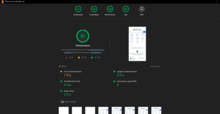Lighthouse is an open-source, automated tool for measuring the quality of web pages developed by Google. It can be run against any web page, public or, requiring authentication. Lighthouse audits performance, accessibility, and search engine optimization factors of web pages, this is the major difference from Google PageSpeed, Lighthouse provides more detail information. It also includes the ability to test progressive web applications for compliance with standards and best practices. Lighthouse aims to help web developers, the tool can be run by using Chrome browser extension or by using terminal (command) for batch auditing a list of URLs. Google's recommendation is for using the online version of Page Speed Insights as of 15th May 2015.
Lighthouse includes a metric for Progressive Web Applications to ensure that PWA's are fast and reliable, installable and optimised for modern 7th and 8th generation mobile technology.
Lighthouse can audit webpage in desktop version and mobile version. In command mode (cmd in Windows), the developer is able to select the factors that need to be audited and other options by using the command line.

Recent versions of Lighthouse offer insights into how to optimize the Core Web Vitals metrics (which is one of the signals used by Google's algorithm to rank pages), as announced by Google engineer Addy Osmani in 2021. As of now, Google uses three parameters to measure Core Web Vitals compliance, which are:
- Largest Contentful Paint (LCP)
- Cumulative Layout Shift (CLS)
- Total Blocking Time (TBT) as a proxy for First Input Delay (FID)
On 10th May 2023, Google announced that INP will replace FID as the metric measuring responsiveness of a page. The move is aimed at getting a better handle on the total time taken for user interactions, rather than just the first interaction. These changes will start affecting page results from March 2024.
See also
References
- "Google Lighthouse: Monitor Site Performance, SEO, Accessibility". May 8, 2018.
- Krill, Paul (2018-05-14). "What's new in Google's Lighthouse". InfoWorld. Retrieved 2019-01-16.
- "Google Releases an SEO Tool that Measures 10 SEO Metrics". Search Engine Journal. 2018-02-06. Retrieved 2019-01-16.
- "PageSpeed Insights". Google for Developers. Retrieved 2023-08-29.
- "PWA Audits". Google for Developers. Retrieved 2023-10-18.
- "Understanding Core Web Vitals and Google search results | Google Search Central | Documentation". Google for Developers. Retrieved 2023-08-29.
- "Optimizing Web Vitals using Lighthouse". web.dev. 2022-01-22. Retrieved 2022-04-08.
- "Introducing INP to Core Web Vitals | Google Search Central Blog". Google for Developers. Retrieved 2023-08-29.
- "INP. Get ready for the new Core Web Vital". The Cloudflare Blog. 2023-06-20. Retrieved 2023-08-29.
External links
| Google free and open-source software | |||||||||
|---|---|---|---|---|---|---|---|---|---|
| Software |
| ||||||||
| Related | |||||||||